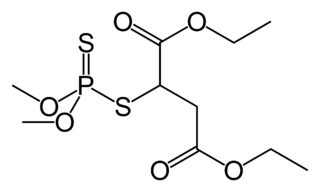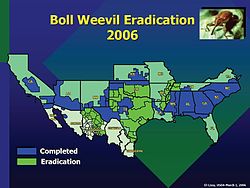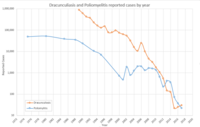
The Japanese beetle is a species of scarab beetle. The adult measures 15 mm (0.6 in) in length and 10 mm (0.4 in) in width, has iridescent copper-colored elytra and a green thorax and head. It is not very destructive in Japan, but in North America and some regions of Europe is a noted pest to roughly 300 species of plants, including rose bushes, grapes, hops, canna, crape myrtles, birch trees, linden trees, and others.

The boll weevil is a beetle that feeds on cotton buds and flowers. Thought to be native to Central Mexico, it migrated into the United States from Mexico in the late 19th century and had infested all U.S. cotton-growing areas by the 1920s, devastating the industry and the people working in the American South. During the late 20th century, it became a serious pest in South America as well. Since 1978, the Boll Weevil Eradication Program in the U.S. allowed full-scale cultivation to resume in many regions.

Pesticide resistance describes the decreased susceptibility of a pest population to a pesticide that was previously effective at controlling the pest. Pest species evolve pesticide resistance via natural selection: the most resistant specimens survive and pass on their acquired heritable changes traits to their offspring. If a pest has resistance then the pesticide lacks efficacy – efficacy and resistance are inversely related.

Helicoverpa zea, commonly known as the corn earworm, is a species in the family Noctuidae. The larva of the moth Helicoverpa zea is a major agricultural pest. Since it is polyphagous during the larval stage, the species has been given many different common names, including the cotton bollworm and the tomato fruitworm. It also consumes a wide variety of other crops.

Malathion is an organophosphate insecticide which acts as an acetylcholinesterase inhibitor. In the USSR, it was known as carbophos, in New Zealand and Australia as maldison and in South Africa as mercaptothion.

Pest control is the regulation or management of a species defined as a pest; any animal, plant or fungus that impacts adversely on human activities or environment. The human response depends on the importance of the damage done and will range from tolerance, through deterrence and management, to attempts to completely eradicate the pest. Pest control measures may be performed as part of an integrated pest management strategy.

In organic chemistry, organophosphates are a class of organophosphorus compounds with the general structure O=P(OR)3, a central phosphate molecule with alkyl or aromatic substituents. They can be considered as esters of phosphoric acid.

The light brown apple moth is a leafroller moth belonging to the lepidopteran family Tortricidae.
Non-pesticidal Management (NPM) describes various pest-control techniques which do not rely on pesticides. It is used in organic production of foodstuff, as well as in other situations in which the introduction of toxins is undesirable. Instead of the use of synthetic toxins, pest control is achieved by biological means.
Maurice James Lukefahr, a pioneer researcher in the fields of host plant resistance and environmental control of cotton insect pests, died in Elsa, Texas in 2002.

Wilmon Newell was an American entomologist.
Mating disruption (MD) is a pest management technique designed to control certain insect pests by introducing artificial stimuli that confuse the individuals and disrupt mate localization and/or courtship, thus preventing mating and blocking the reproductive cycle. It usually involves the use of synthetic sex pheromones, although other approaches, such as interfering with vibrational communication, are also being developed.

The light brown apple moth is a leafroller moth belonging to the lepidopteran family Tortricidae. The moth was confirmed to be present in mainland United States in 2007, principally along the West Coast. The State of California and the US Department of Agriculture quickly imposed quarantine measures and decided to use aerial spraying of cities with pesticides to try to eradicate the moth. This led to substantial public controversy and claims of adverse health effects. Aerial spraying was discontinued in 2008. Trapping, monitoring, and inspection efforts were reduced or eliminated in 2012 due to budget problems.

Pesticide application refers to the practical way in which pesticides are delivered to their biological targets. Public concern about the use of pesticides has highlighted the need to make this process as efficient as possible, in order to minimise their release into the environment and human exposure. The practice of pest management by the rational application of pesticides is supremely multi-disciplinary, combining many aspects of biology and chemistry with: agronomy, engineering, meteorology, socio-economics and public health, together with newer disciplines such as biotechnology and information science.

The environmental effects of pesticides describe the broad series of consequences of using pesticides. The unintended consequences of pesticides is one of the main drivers of the negative impact of modern industrial agriculture on the environment. Pesticides, because they are toxic chemicals meant to kill pest species, can affect non-target species, such as plants, animals and humans. Over 98% of sprayed insecticides and 95% of herbicides reach a destination other than their target species, because they are sprayed or spread across entire agricultural fields. Other agrochemicals, such as fertilizers, can also have negative effects on the environment.

The gypsy moth, also known as the spongy moth, was introduced in 1868 into the United States by Étienne Léopold Trouvelot, a French scientist living in Medford, Massachusetts. Because native silk-spinning caterpillars were susceptible to disease, Trouvelot imported the species in order to breed a more resistant hybrid species. Some of the moths escaped, found suitable habitat, and began breeding. The gypsy moth is now a major pest of hardwood trees in the Eastern United States.

Ectomyelois ceratoniae, the locust bean moth, more ambiguously known as "carob moth", is a moth of the family Pyralidae. It has a nearly cosmopolitan distribution.

Agenor Mafra-Neto is a chemical ecology researcher and entrepreneur in the entomological field of insect chemical ecology. He is the CEO of ISCA Technologies, a company specializing in the development semiochemical solutions for pest management, robotic smart traps and nanosensors. Dr Mafra-Neto is the CEO and Director of Research and Development at ISCA Technologies, Inc. which he founded in 1996 in Riverside, California. ISCA Tecnologias, Ltda was founded in Brazil in 1997.
Plant Protection and Quarantine (PPQ) is one of six operational program units within the Animal and Plant Health Inspection Service (APHIS) of the United States Department of Agriculture (USDA). The PPQ works to safeguard agriculture and natural resources in the U.S. against the entry, establishment, and spread of animal and plant pests and noxious weeds, to help ensure an abundant, high-quality, and varied food supply.
Leo Dale Newsom was an American entomologist and specialist on crop pest management particularly in cotton and soybean cultivation and was known for his approaches to Integrated Pest Management.















